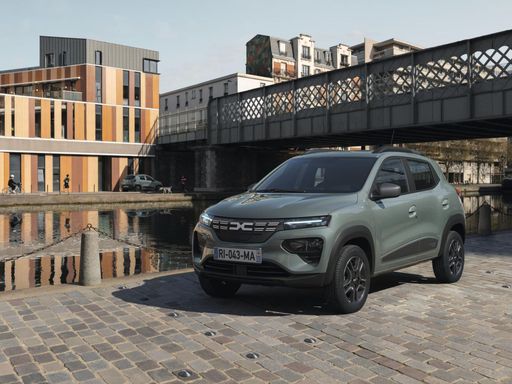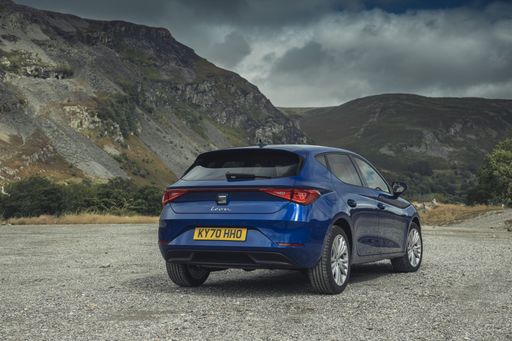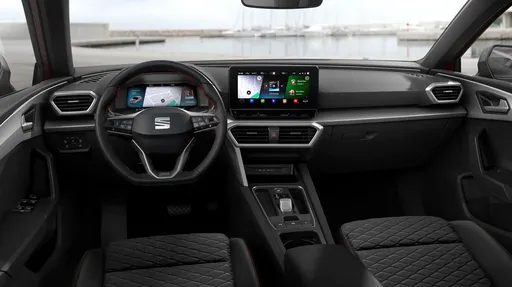Dacia Spring VS SEAT Leon – Specs, Efficiency & Price Comparison
Which model is the better choice – the Dacia Spring or the SEAT Leon? We compare performance (65 HP vs 272 HP), boot capacity (308 L vs 380 L), efficiency (13.20 kWh vs 0.40 L), and of course, the price (14500 £ vs 24100 £).
Find out now which car fits your needs better!
The Dacia Spring (SUV) is powered by a Electric engine and comes with a Automatic transmission. In comparison, the SEAT Leon (Hatchback) features a Petrol, Petrol MHEV, Diesel or Plugin Hybrid engine and a Manuel or Automatic gearbox.
When it comes to boot capacity, the Dacia Spring offers 308 L, while the SEAT Leon provides 380 L – depending on what matters most to you. If you’re looking for more power, you’ll need to decide whether the 65 HP of the Dacia Spring or the 272 HP of the SEAT Leon suits your needs better.
There are also differences in efficiency: 13.20 kWh vs 0.40 L. In terms of price, the Dacia Spring starts at 14500 £, while the SEAT Leon is available from 24100 £.
Compare all the key specs now and find out which model fits your lifestyle best!
Dacia Spring
The Dacia Spring stands out as an affordable and environmentally friendly option in the electric vehicle market, combining practicality with a compact design ideal for urban settings. Its minimalist interior, while basic, provides all the essential features needed for a comfortable drive, reflecting its cost-effective approach. The vehicle's performance suits city driving, making it an appealing choice for those seeking an entry-level electric car.
details @ dacia-presse.de
@ dacia-presse.de
 @ dacia-presse.de
@ dacia-presse.de
 @ dacia-presse.de
@ dacia-presse.de
SEAT Leon
The SEAT Leon impresses with its dynamic design and sporty edge, making it a standout choice in its class. Its interior is characterised by a modern, driver-focused cockpit that combines functionality with an emphasis on comfort. The car delivers a responsive driving experience, thanks to its advanced engineering and agile handling capabilities.
details @ seatmedia
@ seatmedia
 @ seatmedia
@ seatmedia
 @ seatmedia
@ seatmedia
 @ seatmedia
@ seatmedia

|

|
|
|
|
Costs and Consumption |
|
|---|---|
|
Price
14500 - 17100 £
|
Price
24100 - 35700 £
|
|
Consumption L/100km
-
|
Consumption L/100km
0.4 - 5.7 L
|
|
Consumption kWh/100km
13.2 - 14.1 kWh
|
Consumption kWh/100km
-
|
|
Electric Range
225 - 228 km
|
Electric Range
133 km
|
|
Battery Capacity
26.80 kWh
|
Battery Capacity
19.70 kWh
|
|
co2
0 g/km
|
co2
8 - 129 g/km
|
|
Fuel tank capacity
-
|
Fuel tank capacity
40 - 45 L
|
Dimensions and Body |
|
|---|---|
|
Body Type
SUV
|
Body Type
Hatchback
|
|
Seats
4
|
Seats
5
|
|
Doors
5
|
Doors
5
|
|
Curb weight
1030 - 1050 kg
|
Curb weight
1344 - 1670 kg
|
|
Trunk capacity
308 L
|
Trunk capacity
270 - 380 L
|
|
Length
3701 mm
|
Length
4368 mm
|
|
Width
1583 mm
|
Width
1799 mm
|
|
Height
1519 mm
|
Height
1442 - 1460 mm
|
|
Payload
265 - 285 kg
|
Payload
460 - 521 kg
|
Engine and Performance |
|
|---|---|
|
Engine Type
Electric
|
Engine Type
Petrol, Petrol MHEV, Diesel, Plugin Hybrid
|
|
Transmission
Automatic
|
Transmission
Manuel, Automatic
|
|
Transmission Detail
Reduction Gearbox
|
Transmission Detail
Manual Gearbox, Dual-Clutch Automatic
|
|
Drive Type
Front-Wheel Drive
|
Drive Type
Front-Wheel Drive
|
|
Power HP
44 - 65 HP
|
Power HP
110 - 272 HP
|
|
Acceleration 0-100km/h
13.7 - 19.1 s
|
Acceleration 0-100km/h
7.7 - 10.5 s
|
|
Max Speed
125 km/h
|
Max Speed
197 - 220 km/h
|
|
Torque
113 - 125 Nm
|
Torque
220 - 360 Nm
|
|
Number of Cylinders
-
|
Number of Cylinders
4
|
|
Power kW
33 - 48 kW
|
Power kW
85 - 200 kW
|
|
Engine capacity
-
|
Engine capacity
1498 - 1968 cm3
|
General |
|
|---|---|
|
Model Year
2024
|
Model Year
2024 - 2025
|
|
CO2 Efficiency Class
A
|
CO2 Efficiency Class
D, B
|
|
Brand
Dacia
|
Brand
SEAT
|
Dacia Spring
The Revolution of Affordable Electric Mobility: The Dacia Spring
The automotive world has witnessed remarkable advancements in electric vehicles (EVs), with the Dacia Spring emerging as a noteworthy contender in the affordable segment. Combining efficiency, affordability, and practicality, the Spring offers an intriguing prospect for eco-conscious individuals and city dwellers alike.
Powertrain and Performance: A Look Under the Hood
The Dacia Spring is equipped with an electric motor that delivers between 44 to 65 PS, translating into a versatile driving experience tailored to urban landscapes. It operates on a front-wheel-drive system, ensuring a familiar and manageable handling experience.
Dacia Spring's electric engine is paired with an automatic transmission, utilising a reduction gearbox. This setup allows for smooth acceleration and a top speed of 125 km/h, ensuring that everyday driving scenarios are handled with ease.
Efficiency and Range: Eco-Friendly without Compromise
Efficiency is a cornerstone of the Dacia Spring's design, boasting an energy consumption of just 13.2 to 14.1 kWh per 100 km. When fully charged, its 26.8 kWh battery offers a respectable range of 225 to 228 km, making it ideal for daily commutes and short trips.
Furthermore, the Spring takes pride in its commendable CO2-efficiency class A, emphasising its commitment to reducing environmental footprint with a zero-emission profile.
Design and Practicality: Compact yet Comprehensive
Lying in the SUV category, the Dacia Spring is compact with dimensions of 3701 mm in length and 1583 mm in width, making it a perfect match for urban environments where space is at a premium. Despite its modest size, it provides a generous boot space of 308 litres, ensuring practicality isn’t sacrificed.
Comfort and Interior: For the Everyday Journey
The Dacia Spring comfortably seats up to four passengers. The cabin offers a minimalist yet functional design, available in multiple trim lines including Essential, Expression, and Extreme, allowing customers to choose according to their taste and requirement.
With its ergonomic layout and simplicity, the interior is crafted to enhance the driving experience by focusing on essential needs, avoiding unnecessary distractions.
Affordability and Accessibility: Breaking Barrier
The Dacia Spring stands out in the electric vehicle market due to its affordability, with prices ranging from 16,900 to 19,900 €. This ensures that environmentally friendly transportation is accessible to a broader audience.
Additionally, the Spring allows for cost-effective maintenance and operational expenses, offering monthly running costs between 570 to 599 € and cost per km between 22.8 to 24 cents, making it an economical choice in the long run.
Final Thoughts: The Future of Urban Mobility
In summary, the Dacia Spring serves as a testament to how electric vehicles can be both affordable and practical, without compromising on essential features. Whether it is for the eco-conscious urbanite or those looking for a cost-effective daily driver, the Spring is positioned as a viable solution for navigating the future of urban mobility.
SEAT Leon
The SEAT Leon: A Blend of Performance and Innovation
The SEAT Leon has firmly established itself as a standout model, blending sleek aesthetics with cutting-edge technology. Known for its versatility and dynamic performance, this hatchback has become a staple choice for drivers seeking style and substance. Join us as we delve into the technical intricacies and innovative features that make the SEAT Leon a formidable contender in its class.
Dynamic Engine Options
The SEAT Leon offers a diverse range of engine choices, catering to various driving preferences. From efficient petrol options with mild-hybrid technology to powerful diesel engines, the Leon provides an impressive power range between 110 to 204 PS. Drivers can also opt for the environmentally friendly plug-in hybrid, featuring a 1.4 e-HYBRID powertrain that boasts a consumption rate as low as 1.1 L/100km and an electric range of up to 63 km.
Advanced Transmission Systems
Optimising driving efficiency, the SEAT Leon is available with both a manual gearbox and an advanced automatic dual-clutch transmission (DSG). The DSG offers seamless gear changes, enhancing the driving experience by providing precise control and improved fuel economy. This versatility allows the Leon to cater to drivers who appreciate the traditional feel of manual shifting and those who prefer the convenience of automatic transmissions.
Intelligent Design and Comfort
The SEAT Leon’s interior is designed with the modern driver in mind. Sporting a spacious cabin accommodating up to five passengers, it provides a balance of comfort and functionality. The boot space ranges from 270 to 380 litres, ensuring ample room for luggage. The Leon's ergonomic layout, coupled with optional advanced features such as ambient lighting and premium upholstery, positions it as a leader in comfort and practicality.
Cutting-edge Technology and Safety
The SEAT Leon is not just about performance; safety features prominently in its design. It is equipped with the latest driver assistance systems, such as adaptive cruise control and lane-keeping assist, ensuring a safer driving experience. The infotainment system offers seamless connectivity, supporting both Android Auto and Apple CarPlay, enabling drivers to stay connected while on the road.
Efficiency and Sustainable Driving
Emphasising sustainability, the SEAT Leon offers CO2 emissions ranging from 25 to 132 g/km, showcasing its commitment to environmental responsibility. Fuel consumption varies between a thrifty 1.1 to 5.8 L/100km, catering to both eco-conscious drivers and those focused on performance. With a competitive price range, the Leon stands out as an economical choice in its segment, balancing initial cost and long-term benefits.
Conclusion
The SEAT Leon continues to set benchmarks with its combination of style, performance, and technological innovation. Its array of engine options, advanced safety features, and luxurious interior make it a compelling choice for modern drivers. Whether you prioritise fuel efficiency, power, or comfort, the SEAT Leon offers a tailored driving experience unmatched in its class.
The prices and data displayed are estimates based on German list prices and may vary by country. This information is not legally binding.
